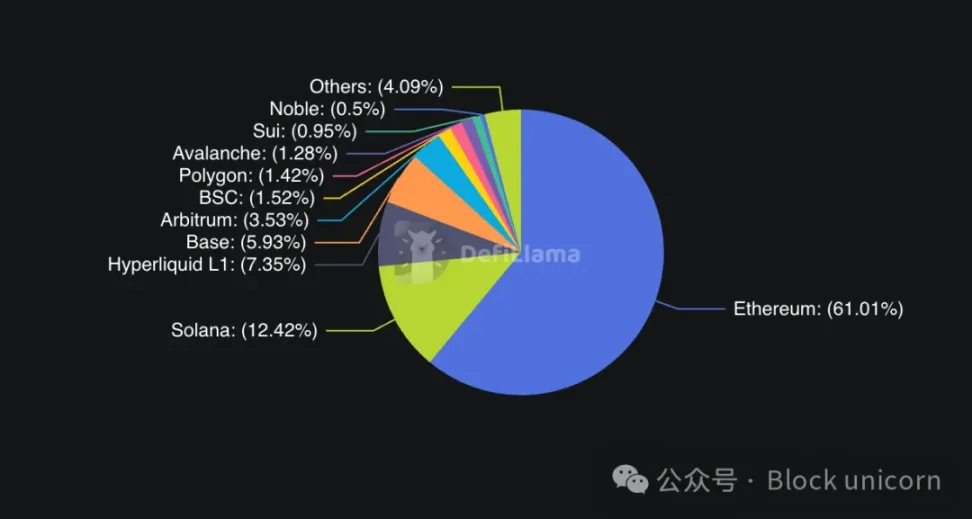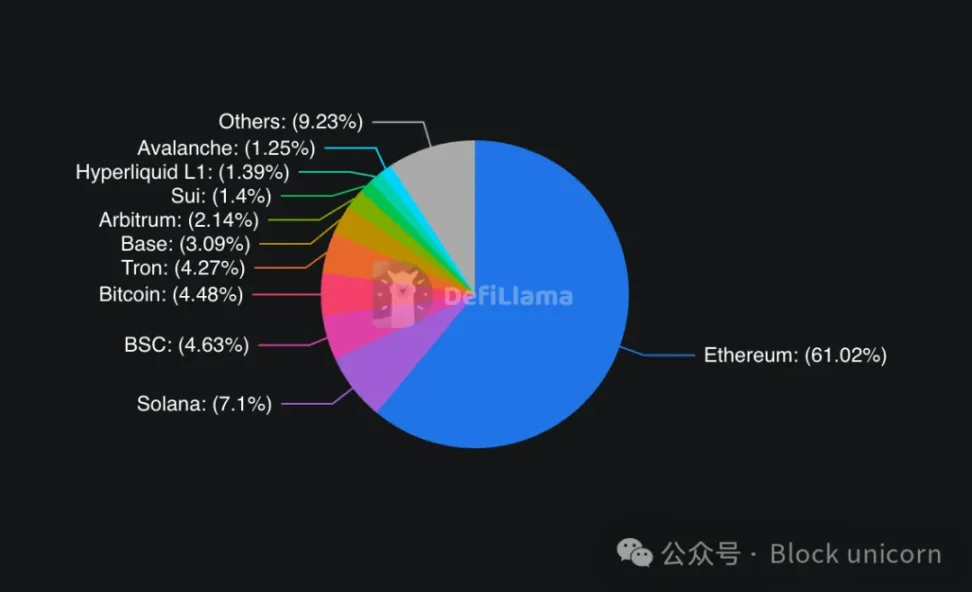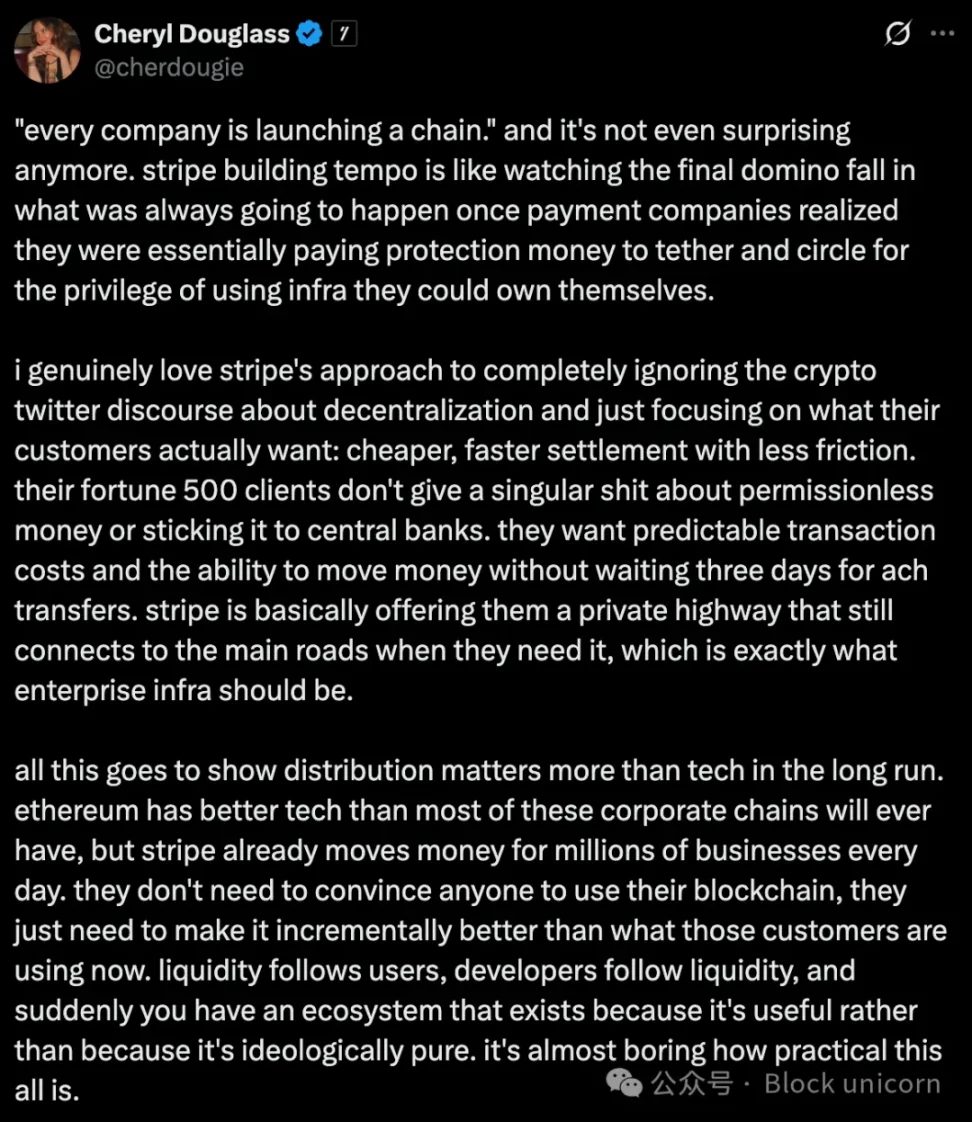Author: Thejaswini M A
Translation: Block unicorn
Introduction
You might buy a few Philips Hue smart bulbs because they are said to be the best. Its app interface is sleek, the colors are vibrant, and when you dim the lights with your phone, you feel like a tech wizard, very high-end.
Then you decide your thermostat should be smart too. Nest has the most powerful AI, so you buy that. Different apps, different accounts, but that’s okay; it’s just another feature.
Before you know it, your life is in chaos. Your Ring doorbell can’t communicate with your Alexa speaker, the Alexa speaker can’t control your Apple HomeKit garage door, and the garage door can’t connect to the Samsung SmartThings hub. You need four different apps to turn on lights, adjust the temperature, and lock doors. Every company promises you a "seamless smart home experience," but somehow your house feels "heavier" than before, just with a few more apps.
Will Circle and Stripe repeat this in the cryptocurrency space?
Circle and Stripe
In August 2025, two major announcements were made.
First, it was reported that the $50 billion payment giant Stripe is collaborating with crypto venture capital firm Paradigm to develop a blockchain called Tempo, which is "high-performance and payment-focused." A day later, Circle, the company behind the $67 billion USDC stablecoin, announced the Arc project, a Layer 1 blockchain designed specifically for stablecoin payments, foreign exchange trading, and capital markets.
Inside Circle Arc: Circle has built Arc specifically around its USDC stablecoin. Most blockchains require you to pay transaction fees with their native tokens. For example, Ethereum uses ETH, and Solana uses SOL. However, on Arc, you can pay fees directly with USDC, without needing to hold volatile tokens to use the network.
Arc has a built-in foreign exchange engine. There’s no need to use external services or decentralized exchanges (DEX) to exchange currencies; Arc handles foreign exchange transactions natively at the protocol level. Send USDC, and the recipient will receive EURC (Euro Coin), with the conversion process automatically completed without third-party services or additional fees.
There’s also privacy control. Most public blockchains (Ethereum, Bitcoin, Solana) make all information public: addresses, amounts, times. Privacy coins like Monero hide everything by default. Arc offers selective privacy, allowing institutions to hide transaction amounts while keeping addresses visible, and it has built-in regulatory compliance features. It is designed for businesses that need competitive privacy but not complete anonymity.
Inside Stripe Tempo: Stripe’s differentiation seems to lie in the abstraction of user experience. Other crypto payment solutions still feel like using cryptocurrency—connecting wallets, signing transactions, waiting for confirmations—while Tempo seems designed to make blockchain payments feel indistinguishable from credit card payments from the user’s perspective.
Being Ethereum-compatible means it can leverage existing DeFi infrastructure and developer tools, but the advantage lies in integrating with Stripe’s existing merchant ecosystem. Millions of businesses using Stripe can add crypto payment functionality without changing their checkout processes or learning new systems.
Most importantly, Stripe’s existing relationships with banks and regulators can solve a significant problem. Most crypto payment solutions struggle with the "last mile"—moving funds from the blockchain back to regular bank accounts. Stripe already has banking partnerships that other crypto companies have spent years building.
Why I Still Feel Troubled
So, we return to my digitally fragmented home, where the problems start multiplying, just like the notification badges on my various home automation apps.
What troubles me first is: where is the demand for these dedicated blockchains?
Circle and Stripe have been talking about stablecoin payments and enterprise features, but the real active area for stablecoins is in DeFi. People use USDC to buy other crypto assets, participate in lending protocols, trade on decentralized exchanges, and interact with a broader ecosystem of financial applications. All of this primarily takes place on Ethereum.

It’s like building the world’s most advanced smart thermostat but only being able to use it in a house without any other smart devices.
Sure, this thermostat might be technically superior, but you’ve isolated yourself from the entire ecosystem where people actually want to use smart home features.
The second question: what’s the point of reinventing the wheel?
Everything Circle and Stripe are pursuing—faster transaction speeds, lower fees, customizable features, enterprise branding—can be achieved through Ethereum Layer 2 solutions. You can gain the security of Ethereum’s base layer, access the largest DeFi ecosystem, and customize your network on demand.
Some Layer 1 blockchains have already realized this. The mobile payment-focused independent blockchain Celo announced plans to transition to Ethereum Layer 2. They did the math and found that joining the Ethereum ecosystem made more sense than building their own network effects from scratch.
The more blockchains there are, the more bridges are needed. And bridges are the problem… they transfer assets between different blockchains. Essentially, they lock your tokens on one chain through complex smart contracts and then mint equivalent tokens on another chain. But bridges are often hacked. Really often. I swear by Ronin. We’re not talking about the minor inconvenience of switching from the Philips Hue app to the Nest app. We’re talking about potential economic losses if the bridge software has issues.
The user experience is poor. In my smart home, the worst-case scenario is that I have to open another app to turn off the porch light. But for enterprise blockchains, users might need to use different wallets, different gas tokens, different interfaces, and different security settings for each network. Most people already struggle to manage one crypto wallet. Imagine explaining why they need to use different wallets for Stripe payments and Circle transfers.
But what truly confuses me is that the network effects simply don’t exist.
The value of a payment network grows exponentially with the number of users and applications. Ethereum has the most developers, the most applications, and the most liquidity. As of mid-2025, Ethereum’s TVL (Total Value Locked) was $96 billion, accounting for about 60-65% of DeFi activity. Solana, as a high-performance alternative, had a TVL of $11 billion. Other major chains like Binance Smart Chain ($7.35 billion), Tron ($6.78 billion), and Arbitrum ($3.39 billion) split the remaining portion.

These enterprise chains are opting out of this network effect to build something isolated, hoping users will come automatically.
Would you build a perfect store on a deserted island? Sure, countries like the UAE have built cities like Dubai, and people did come. But that was due to geographical constraints. They had to do it.
Finally, there’s a competitive issue that no one wants to face directly. Are these companies really trying to build better infrastructure, or are they just unwilling to share the "sandbox" with competitors? When I examine the chaos of my smart home, I find that each company has reasonable technical justifications for their choices. But the real driving force is often that they don’t want to rely on someone else’s platform or pay fees to competitors.
Maybe that’s the reality. Circle doesn’t want to pay Ethereum transaction fees, and Stripe doesn’t want to build on infrastructure they can’t control. That makes sense. But let’s be honest about what this is really about. It’s not about innovation or user experience; it’s about control and economic benefits.
The true kings don’t seem to worry
Ethereum doesn’t seem to care much about this. The network processes over a million transactions daily, capturing most of the DeFi activity, and has recently seen massive institutional inflows through its ETFs. On one day in August, the net inflow for Ethereum ETFs reached $1 billion, surpassing the total for Bitcoin ETFs over the past week.
The Ethereum community’s reaction to these enterprise chains is interesting. Some see it as validation. After all, both Arc and Tempo are built as EVM-compatible chains, essentially adopting Ethereum’s development standards.
But there’s a subtle threat here. Every USDC transaction conducted on Arc instead of Ethereum is a fee revenue that does not flow to Ethereum validators. Every merchant payment processed on Tempo instead of Ethereum Layer 2 is an activity that does not contribute to Ethereum’s network effect.
Solana may feel this competition more acutely. The network positions itself as a high-performance alternative to Ethereum, especially in payments and consumer applications. When large payment companies choose to build their own chains instead of adopting Solana, it undermines Solana’s long-promoted argument that "everything can run on a fast computer."
The Graveyard of Enterprise Blockchains
History has not been kind to companies that attempt to build their own blockchains. As I mentioned earlier, Celo made the same move in 2023.
Remember Facebook’s Libra? It started as an ambitious plan to create a global digital currency, then became Diem, and eventually became unsustainable under regulatory pressure, leading to its breakup and sale. Don’t forget that under today’s clearer rules, the GENIUS Act explicitly outlines how stablecoin issuers should operate, and Facebook’s project might actually succeed.
JPMorgan’s blockchain attempts may provide the most relevant cautionary tale. The bank spent years developing JPM Coin (digital dollar), Quorum (their private blockchain network), and other blockchain projects. Despite having almost unlimited resources, regulatory relationships, and a large existing customer base, these projects never gained meaningful adoption outside of JPMorgan’s own business. JPM Coin processed billions of dollars in transactions, but primarily just for fund transfers between institutional clients within the bank.
Even the attempts of large payment companies are not particularly exciting. In 2023, PayPal launched its own stablecoin (PYUSD), becoming the first major U.S. fintech company to enter the stablecoin space. However, PayPal chose to launch on existing networks like Ethereum rather than building custom infrastructure. The result? PYUSD has a market cap of only $1.102 billion, which is negligible compared to USDC's $67 billion, and is primarily confined to PayPal's own ecosystem.
This raises a question: if a company with the extensive influence and payment expertise of PayPal cannot make a significant impact with just a stablecoin, why do Circle and Stripe believe that building an entire blockchain will perform better?
This pattern suggests that building a successful blockchain requires more than just technical capability and financial resources. You need network effects, developer enthusiasm, and organic adoption—elements that are extremely difficult to manufacture even with corporate backing.
Will this time be different?
We have reason to believe that Circle and Stripe may succeed where other companies struggle.
First, regulatory transparency has significantly improved. The GENIUS Act passed in the U.S. provides a clear framework for stablecoin issuers, eliminating much of the uncertainty faced by early enterprise blockchain efforts. When Circle launched Arc, they were no longer operating in a legal gray area. They are a publicly traded company operating under clear rules.
Second, these two companies already possess what JPMorgan lacks: a large user base that is not primarily focused on cryptocurrency. Stripe processes over $1 trillion in transactions annually for millions of merchants worldwide and has been systematically building its crypto infrastructure—acquiring Bridge (stablecoin infrastructure) and Privy (crypto wallet technology) for $1.1 billion to create an end-to-end payment stack. Circle's USDC is integrated into hundreds of applications and trading platforms. They are not building a blockchain and hoping someone will use it; they are building infrastructure for the users they already serve and providing tools for seamless access.
Matt Huang from Paradigm emphasized how Stripe's strategy allows blockchain technology to "fade out" of the ordinary user's view. Imagine online payments with instant settlement, lower fees, and programmable features, but the merchant integration looks exactly like the existing Stripe checkout process. This is completely different from asking people to download MetaMask and manage seed phrases. It’s a combination of Web2 user experience with Web3 infrastructure. Users may not even feel any "blockchain flavor."
Third, the technology itself has matured. When JPMorgan experimented with blockchain in 2017-2018, the infrastructure was indeed very primitive. Today, building a high-performance blockchain with institutional-grade functionality, while challenging, is not unprecedented. Circle acquired the Malachite consensus engine team, providing them with battle-tested sub-second finality technology. Stripe's collaboration with Paradigm brings deep crypto expertise to complement its payment knowledge.
Cost dynamics have also changed dramatically. In 2017, launching a new blockchain typically required $1 million to $5 million, with development cycles of 1-2 years or longer. By 2025, the average cost of launching a functional blockchain application is expected to be between $40,000 and $200,000, usually taking 3-6 months, thanks to improved developer tools, consensus engines, and blockchain-as-a-service platforms. Modern deployments can be up to 43% cheaper in certain areas than centralized applications, due to efficiency gains and infrastructure scaling.
Payment companies realize they are paying for infrastructure that they could have built themselves. Instead of paying Circle fees for USDC transactions or relying on Ethereum's fee structure, companies like Stripe can now build their own infrastructure stack at a fraction of the long-term costs they would pay to third parties.
This is a classic "build or buy" decision, where the cost of building has dropped from millions to hundreds of thousands.

The Coexistence Question
So, where does this lead us? Are we heading toward a fragmented future where every large company runs its own blockchain, or will market forces drive integration and interoperability?
Early signs suggest that the future is more likely to be one of pragmatic coexistence rather than winner-takes-all competition. Circle has made it clear that Arc will complement rather than replace its multi-chain strategy. USDC will continue to operate on Ethereum, Solana, and dozens of other networks. Arc is positioned as an additional option for users who need specific features, such as institutional privacy, guaranteed settlement times, or built-in foreign exchange capabilities.
Stripe's strategy seems similar. Tempo is not intended to completely replace existing payment channels but to provide alternatives for use cases where blockchain functionality has clear advantages. Cross-border payments, programmable money, and merchant settlements are areas where blockchain technology truly outperforms traditional systems.
User experience will ultimately determine whether this fragmentation becomes a feature or a problem. If "chain abstraction" technologies develop as promised, users may unknowingly use different blockchains. Your payment application might automatically route transactions through the network that offers the best speed and cost.
My guess (if I’m a bit optimistic) is that we will see both outcomes simultaneously, but in different market segments.
For institutional and enterprise users, multiple dedicated blockchains may thrive. A multinational company transferring $100 million between subsidiaries cares about compliance features, settlement guarantees, and integration with existing financial systems. They are not concerned about gas price fluctuations, whether their blockchain has the coolest NFT projects, or the most active DeFi protocols. A chain that allows enterprises to connect directly to traditional banking systems, provides built-in regulatory reporting, or guarantees settlement times will be more popular than Ethereum's general-purpose infrastructure.
Arc may indeed serve these users better than Ethereum.
Stable fees, instant settlement, and built-in compliance features may be more important to CFOs than access to the latest DeFi protocols.
For retail users and developers, network effects remain crucial. The blockchain with the most applications, the most liquidity, and the most developer activity will continue to attract more of the same. Today, that is still Ethereum, and these enterprise chains do not seem to directly challenge that dominance.
One variable is whether these enterprise blockchains will remain enterprise-focused. If Stripe offers merchants faster and cheaper payment options, and customers are unaware that they are using a blockchain, it could potentially extend beyond enterprise applications.
But the key to infrastructure is that the best kind is invisible. When you flip the light switch, you don’t think about the power plant or the transmission lines. When these blockchain experiments succeed, it will be because they make the underlying technology completely disappear.
Whether this will truly happen remains to be seen. For now, we are in a phase of territorial competition, with everyone wanting a piece of the future financial infrastructure.
免责声明:本文章仅代表作者个人观点,不代表本平台的立场和观点。本文章仅供信息分享,不构成对任何人的任何投资建议。用户与作者之间的任何争议,与本平台无关。如网页中刊载的文章或图片涉及侵权,请提供相关的权利证明和身份证明发送邮件到support@aicoin.com,本平台相关工作人员将会进行核查。




